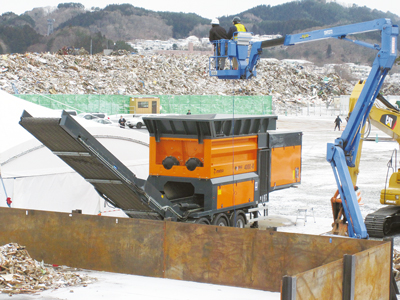
Japanese ferrous scrap industry is facing potential business structure changes after the Japan Earthquake. Great volume of disaster refuses generated by the Earthquake and Tsunami which could become valuable materials for steel products. Meanwhile, in Tohoku area, demand and supply balance of ferrous scrap seems gradually changing.
Ten scrap dealers in Tohoku area, out of seventy regional members of Japan Iron & Steel Recycling Institute, were forced to suspend operations after the Japan Earthquake. Other dealers in Tohoku inland or Kanto area were also impacted by electric power and fuel shortages until April. Seinan Group, the largest recycle company in Tohoku, suspended operations of Sendai, Shiogama and Kouriyama plants on March 11. Shiogama and Kouriyama plants were recommenced in May. Sendai plant also restarted scrap acceptance. Around Sendai Port, electricity supply recovered in October. Then scrap dealers around the Port could restart shearing and shredder processing. Disaster refuses in Iwate, Miyagi and Fukushima Prefectures totaled 22.528 million tonnes, about 1.7 times of the volume of the Hanshin Awaji Earthquake. Ferrous scrap generation is estimated at 1.015 million tonnes and recoverable volume at 966,000 tonnes, according to Steel Recycling Research Corporation. Miyagi Prefecture accounts for 705,000 tonnes, which represents about 70% of total ferrous scrap generation. This volume is equivalent to 1.8 times of the Prefecture’s scrap annual supply of 385,000 tonnes in 2010 and usual 2-year scrap generation. Meanwhile, ferrous scrap supply was concerned to become excess against the local demand since regional scrap consumption decreases. JFE Steel decided to integrate the group’s four electric furnace steel makers. As a result, closure of Tohoku Steel was decided. In Tohoku, there had been four electric furnaces including Tohoku Steel. Tohoku Steel had produced steel bar at 260,000 tonnes in fiscal 2010 ended in March 2011. One local scrap dealer said some of steel makers are offering very low prices against scrap dealers due to scrap oversupply. Just after the Japan Earthquake, some of ferrous scrap dealers considered surplus ferrous scrap might flow out from Tohoku area to Kanto area and supply might loosen especially in Northern Kanto area. However, the supply and demand balance didn’t change largely in fact. Scrap dealers in Tohoku area has relatively large yards and they could wait for recommencement of local electric furnace steel makers, instead of hasty scrap shipment to outer areas with additional freight at 1,000-3,000 yen per tonne. Another background is that areal restoration has delayed in Tohoku than initially expected. Demolitions of damaged plants and buildings haven’t progressed smoothly. One scrap dealer said it was expected that ferrous scrap generation would accumulate approximately 1 million tonnes in Tohoku for 2-3 years but local scrap dealers currently consider it might take ten years or longer at present pace. Scrap circulation system in Tohoku area might change in medium and long terms. One scrap dealer pointed out regional scrap demand would shrink more in Tohoku while scrap generation should also decrease in the region when manufacturing industry was seriously damaged by the disaster. The dealer sees scrap dealers in Tohoku area will experience even tougher survivals under the situation.











